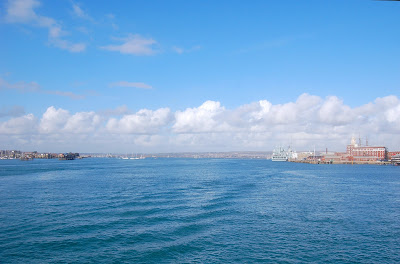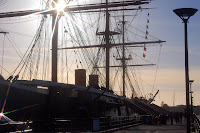
On the way to Cambridge, we stopped at an American war cemetary, which was intersting... yet I felt only done because we are Americans, and thus it was a little silly. Our British tour guide got the staff to give us free booklets about the site because we are American.

Cambridge, which the folks here call 'the other place,' was a very lovely city. I think I may have even liked it better than Oxford, though it is hard to say after only a day's visit. I think it may have only seemed more beautiful because of its seclusion and the fact that all the beautiful buildings were not clustered on top of one another. In Oxford, a building may be extraodinary, but you can't fully appreciate it because it's right next to five other amazing buildings; the sense of beauty is dulled, whereas the nature of Cambridge enhances it.

I wasn't aware that Cambridge placed such an emphasis on the sciences and technology. We visited the 'modern' part of campus, which was very modern indeed and featured a European headquarters for Microsoft and a huge academic building patronized by Bill Gates.
We visited King's College, which was exceedingly beautiful, particularly its cathedral. This had been filled with propogandic bas-reliefs by Henry VIII and then used as a stable for Oliver Cromwell's army during their campaigns to destroy priceless stained-glass and other royal iconography during the Civil War. Luckily, the usefulness of the building's windows to keeping the army and animals warm prevented their destruction. Oh and it also has the largest fan vaulting, I think in the world.

I ate lunch at a pub called The Eagle, where Watson and Crick discussed their research. While they 'discovered' DNA, I discovered that Steak and Ale Pie is the most delicious thing ever.
In other news, Hugh Laurie attended Cambridge, where he pursued rowing, following in the footsteps of his Olympic-winning father, that is until he lost to Oxford, and decided to turn to acting.

Cambridge also presented by far one of the coolest things I have ever seen--a clock built by alumnus John Taylor. It possesses a large gear that ticks in rotation with each second, whilst a large and sinister insect hybrid sits atop and eats the passing moments. For you Greek-learned, the architect fittingly named it the 'Chronophage.' It is supposed to remind us of Time's consuming nature, and that it is not on our side. There is also more to it about the time only being completely accurate every once in awhile, but I did not really understand that bit. While slightly creepy, it was completely awesome. Sadly my picture did not come out well, but it's really something you need to see in person for the full impact anyway.

To escape the cool, English drizzle we retreated to Cambridge's free museum (I'm loving this country's embrace of free museums), which like most others here, consisted mostly of Greek, Roman and Egyptian artifacts. Apparently somewhere in one of the libraries was the first manuscript of Winnie the Pooh, though I did not get to see it.



 I ate lunch at a pub called The Eagle, where Watson and Crick discussed their research. While they 'discovered' DNA, I discovered that Steak and Ale Pie is the most delicious thing ever.
I ate lunch at a pub called The Eagle, where Watson and Crick discussed their research. While they 'discovered' DNA, I discovered that Steak and Ale Pie is the most delicious thing ever. 


























 Unfortunately I don’t live in the college, but rather a pit of an apartment complex, twenty minutes (on foot) from the center of town. But luckily there’s an absolutely gorgeous meadow nearby, which, as a local told us, was documented by William the Conqueror in his surve
Unfortunately I don’t live in the college, but rather a pit of an apartment complex, twenty minutes (on foot) from the center of town. But luckily there’s an absolutely gorgeous meadow nearby, which, as a local told us, was documented by William the Conqueror in his surve

